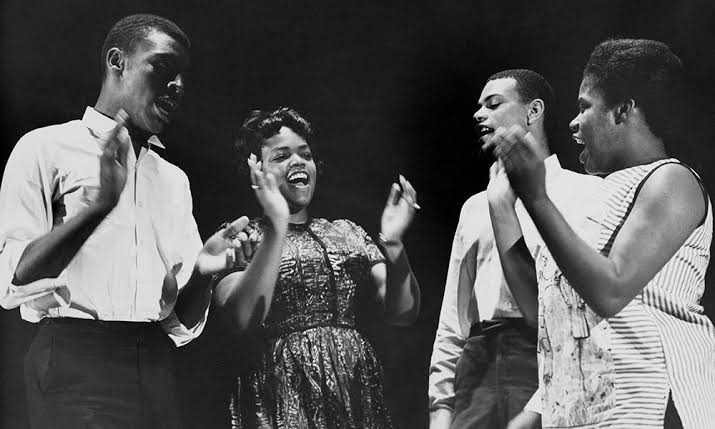Gospel music, spoken word, and ministrations have always been about lifting spirits and pointing souls upward. But lately, something’s shifting—and it’s got people talking. Artists and ministers are sprinkling secular trends, catchy slang, and worldly vibes into their craft, all in a bid to infuse the “woke” concept. It’s a move to feel familiar, to connect. And yeah, it works—the applause swells, the responses pop. But here’s the plea echoing through the pews and playlists: Go easy, please. Too much, and we might lose what makes gospel, well, gospel.
The Game Plan: Familiarity for the Win
Why the shift? Simple: people love what they know. When a gospel artist drops a “no be Gadus be this” or “vibe check” into a song, or a minister tosses in a trending phrase like “no cap” during a spoken word piece, it’s like a wink to the audience—I get you. Suddenly, the youth in the back row perk up, the TikTok crowd hits replay, and the applause feels more like a concert than a church service. Take artists like Travis Greene, who’s been known to blend soulful praise with beats that could slide into an R&B playlist. Or ministers weaving pop culture refs into their messages to keep the congregation locked in. It’s smart—familiarity breeds response.

On X, folks are noticing. One user quipped, “Gospel artists adding slang just to get us hype—abeg, small small o.” Another praised the tactic: “If ‘blessed and highly favored’ comes with a trap beat, I’m here for it.” The divide is real: some see it as a bridge to the unchurched, others as a slippery slope.
The Upside: Reaching the Streets
There’s a solid case for this fusion. Gospel’s mission has always been to spread the word, right? If tossing in a secular hook or a trending phrase gets a Gen Z listener to pause their Drake playlist and lean into a message of hope, that’s a win. Think Kirk Franklin—he’s been remixing gospel with hip-hop since the ’90s, turning “Stomp” into a crossover anthem that still slaps. Today’s artists are just following the playbook, tweaking it for 2025’s soundscape. A spoken word piece with a “drip” reference or a song shouting “God’s the plug” might feel worldly, but it’s bait on the hook—reeling in souls who’d otherwise tune out.
History backs this up. Gospel’s never been static. From Negro spirituals to Mahalia Jackson’s jazz-infused praise, it’s adapted to the times. So why not now? A little secular spice could be the key to keeping the message alive in a world drowning in distraction.
The Flip Side: Too Much Sauce?
But here’s where the “small small” plea kicks in. When you lean too hard into secular trends, the line blurs. If a gospel song sounds like it could play at a club, or a ministration feels like a stand-up routine, what’s the difference? The applause might grow, but the spirit might shrink. Critics argue it’s a popularity grab—pandering to the crowd instead of preaching to the soul. One X post nailed it: “Gospel shouldn’t need slang to slap. The message should hit harder than the beat.”
The worry’s legit. Gospel’s power lies in its otherness—its ability to stand apart from the world’s noise. Load it with too much slang or trendy fluff, and it risks becoming background music, not a lifeline. Ministers chasing “yasss” from the congregation might forget the still, small voice they’re meant to amplify. Small small, abeg—don’t drown the sacred in the sauce.
The Stance: Season, Don’t Smother
Here’s my take: a pinch of secular flavor? Fine. It’s seasoning, not the main dish. A gospel song can ride a modern beat or drop a relatable phrase—just don’t let it overshadow the message. Same goes for ministrations and spoken word: connect with the audience, but don’t trade depth for laughs. The best artists and ministers pull this off with finesse. Think Lecrae, balancing bars and belief, or Tye Tribbett, whose energy feels fresh but never forced. They prove you can vibe with the culture without losing the cross.
Your Call: What’s the Limit?
This trend’s on us, too. We clap, we stream, we share—what are we cheering for? If we only hype the gospel that mirrors the world, that’s what we’ll get. But if we crave something deeper, something that stirs the spirit even without the slang, we’ve got to demand it. So, artists and ministers, keep reaching the crowd—just do it small small. Let the message, not the trend, get the loudest response.

In 2025, gospel’s at a fork in the road. Secular trends can open doors, but they shouldn’t redefine the house. The applause is nice, but the anointing’s better. Let’s keep the conversation going—on X, in churches, everywhere. How much world can gospel take before it stops feeling holy? Small small, folks. That’s the sweet spot.




 Premier League
Premier League